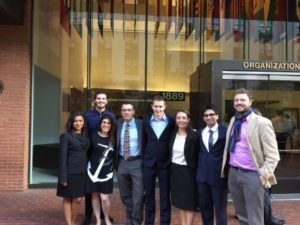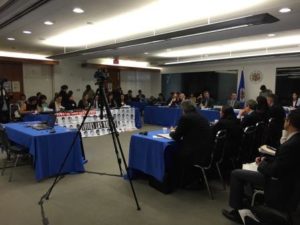A Rare Opportunity to Observe the Inter-American Commission on Human Rights In Action
During the week of October 27, 2014, Naomi Tom (JD ’16), one of five students from the International Human Rights and Conflict Resolution Clinic (IHRCRC), had the opportunity to attend the 153rd Period of Sessions of the Inter-American Commission on Human Rights (IACHR) in Washington, DC. Naomi shares her impressions of this unique experience as well as highlights of some of the hearings she witnessed.
One of the most valuable functions of the IACHR is to hear cases brought by individuals across the Americas seeking justice from an international commission in a public setting. The 153rd Period of Sessions were held between October 23 to November 7, 2014, and we were fortunate to attend sessions and hearings held October 27 through October 31. We observed cases brought by indigenous individual petitioners before IAC member states such as Argentina, Costa Rica, Ecuador, Mexico and Nicaragua, as well as the United States.

It was a unique experience to observe petitioners from various states utilizing this forum to bring their complaints to the Commission. Both sides to an argument were able to present their views uninterrupted during the first twenty minutes of the hearing, allowing each party to state their case and in the manner most effective – which varied depending on the issue and the petitioners. At all but one hearing that our group attended the state gave their response second. At times this setup served to undermine the states’ position from the outset. In general, it seemed as though publicity given to certain sessions may have been the most effective tool for increasing state responsiveness and compelling government officials to be more truthful and transparent during proceedings. The function of the Commissioners was to ask each side questions that ended up either strengthening or undermining the parties’ arguments.
Highlights from Observed IAC Cases. The full chronology of hearings, together with video and still photos, can be viewed here.
Case 12.626 – Jessica Lenahan, United States. Petitioner Jessica Lenahan spoke about the night her daughters were killed, when her husband, who was under a restraining order, took the girls and proceeded to enter a shootout with the local police. By the time local authorities responded, it was too late. It was powerful to listen to her testimony as she addressed the state respondents directly, asking for reparations and apologies for their lack of an appropriate response during the situation. The state, in turn, largely talked around Lenahan’s requests without ever actually addressing them, stating that they had no authority to launch investigations of individual cases, and refusing to offer the apology requested.
Human Rights Situation of Persons Deprived of Liberty in Buenos Aires (October 28). It was unconvincing to watch the state present a video depicting prisoners baking bread and tending pigs, when only minutes before we heard recounts of prison visits describing rotting food and peeling paint in the facilities.
National Human Rights Program in Mexico (October 30). In the wake of the disappearance and suspected murders of 43 missing Mexican students, media coverage and public protests leading up to and following this hearing were on full display. A group of protesters stood outside the courtroom chanting “Cuando?” (When?) and “Ahora!” (Now!) as a call to the Mexican government to fully investigate the students’ disappearance. When the Mexican state observed a moment of silence for the missing students, media and audience members clamored to capture the images in photographs and video. Such coverage contrasted sharply with other sessions, such as during the Monitoring the Report of the Commission on the Situation of Human Rights in Jamaica session (October 28), which was disappointingly sparsely attended.
My general impressions: the public nature of these sessions heightens the need for states to be cautious in their responses; at times they conceded that certain areas needed improvement, while at other times they were evasive. In one case, the “Human Rights Situation of Persons Deprived of Liberty in Texas,” the state didn’t even show up. States had varying opinions of the authority of the IACHR, and some were more vocal of their criticisms than others. As these hearings gain more publicity, as seen particularly during several of the Latin American sessions, perhaps states such as the United States and Venezuela will become more responsive. Regardless of the level of commitment by various states to the IACHR’s proceedings, it was fascinating to see the way in which they interacted with petitioners and to hear their responses regarding a number of critical human rights issues in this public forum. ◊
-

- A view from the gallery – the National Human Rights Program in Mexico hearing
